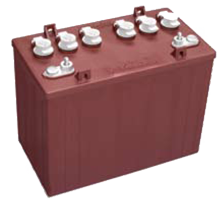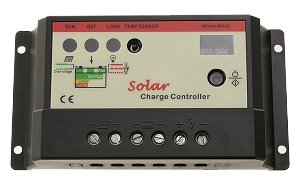Living Off The Grid
In West Branch Michigan
Electrical Storage
Introduction
 Now that you created power using your photovoltaic or wind systems you need to store
that energy for use. Saved energy can be used at night or during periods of bad weather
conditions. Batteries in photovoltaic and wind systems are often charged and discharged
repeatedly, therefore only certain types of batteries are acceptable for use in these systems.
For example, car batteries are designed to discharge a large amount of amps over a short
period of time and are not suitable for electrical storage for solar or wind systems.
There are many solar battery types available in the market. but the single most used type
of battery is the lead acid true deep cycle battery. These batteries have larger and thicker
plates which gives the batteries longer life when deeply discharged. A deep cycle
battery can be discharged to 80% and recharged hundreds and even thousands of times.
Life time of these batteries can be between 6 - 10 years when properly maintained.
Now that you created power using your photovoltaic or wind systems you need to store
that energy for use. Saved energy can be used at night or during periods of bad weather
conditions. Batteries in photovoltaic and wind systems are often charged and discharged
repeatedly, therefore only certain types of batteries are acceptable for use in these systems.
For example, car batteries are designed to discharge a large amount of amps over a short
period of time and are not suitable for electrical storage for solar or wind systems.
There are many solar battery types available in the market. but the single most used type
of battery is the lead acid true deep cycle battery. These batteries have larger and thicker
plates which gives the batteries longer life when deeply discharged. A deep cycle
battery can be discharged to 80% and recharged hundreds and even thousands of times.
Life time of these batteries can be between 6 - 10 years when properly maintained.
Proper maintenance of the batteries will ensure a long and efficient life. To ensure the good working condition of your batteries you should take the following maintenance steps:
- Fully charge your battery before use.
- Be sure to fully tighten the connectors and properly wire all the cables.
- Fasten vent caps tightly and check from time to time.
- Batteries should be wiped free of all corrosion, dust and dirt frequently.
- Water the batteries after extended charging. If the plates have been exposed before charging, cover them with a thin layer of water.
- Check the acid level after charging. Your acid level should be kept 1/4" below the bottom of the fill well in the cell cover.
- Never fill or overfill the cells. When the battery charges, the electrolyte can overflow, causing corrosion and other damage.
- Use distilled or treated water.
- A deep cycle battery is designed to withstand a depth of discharge of 80 percent, but if this can be avoided, do so. The best way to avoid this is to keep discharges to a minimum. Properly sizing your battery is one way to do this. Another is to build a battery bank.
Batteries should be checked at least one per month to make sure they are in proper working condition. From time to time you will need to add water to your batteries. Follow these instructions for proper watering.
- Minimum electrolyte level is at the top of the plates.
- Open the vent caps and look inside the fill wells.
- If necessary add just enough water to cover the plates at this time. Add water until the electrolyte level is 1/8" below the bottom of the fill well.
- Put batteries on a complete charge before adding any additional water.
- Charge batteries completely.
- Clean, replace, and tighten all vent caps.
- WARNING: Never add acid to a battery.
 You don't want to over charge or over discharge your battery system therefore you should use a
charge controller to monitor your battery's state of charge. These systems will monitor your
battery's state of charge and only allow enough power to maintain a proper charge level.
A three-stage charger is recommended. Also called “automatic”, “smart” or “IEI” chargers,
these chargers prolong battery life with their well programmed charging profile. These chargers
usually have three distinct charging stages: Bulk, Absorption, and Float. Bulk - During this stage
the voltage is gradually brought up to the Bulk charging level (usually 14.4 Vdc to 14.6 Vdc for
a 12 Vdc system) At the same time the batteries draw the maximum amount of current. After the
batteries reach the Bulk voltage level the Absorption stage begins. This stage maintains the
Bulk voltage while the current is gradually reduced. Finally, the charger reaches the Float
stage. During this stage the voltage is lowered to the Float level (13.4 Vdc to 13.7 Vdc) and
the batteries draw a small maintenance current.
You don't want to over charge or over discharge your battery system therefore you should use a
charge controller to monitor your battery's state of charge. These systems will monitor your
battery's state of charge and only allow enough power to maintain a proper charge level.
A three-stage charger is recommended. Also called “automatic”, “smart” or “IEI” chargers,
these chargers prolong battery life with their well programmed charging profile. These chargers
usually have three distinct charging stages: Bulk, Absorption, and Float. Bulk - During this stage
the voltage is gradually brought up to the Bulk charging level (usually 14.4 Vdc to 14.6 Vdc for
a 12 Vdc system) At the same time the batteries draw the maximum amount of current. After the
batteries reach the Bulk voltage level the Absorption stage begins. This stage maintains the
Bulk voltage while the current is gradually reduced. Finally, the charger reaches the Float
stage. During this stage the voltage is lowered to the Float level (13.4 Vdc to 13.7 Vdc) and
the batteries draw a small maintenance current.
When your batteries have outlived their usefulness then you should recycle them. Lead-acid batteries are the environmental success story of our time because more than 97 percent of all battery lead is recycled. In fact, lead-acid batteries top the list of the most highly recycled consumer products. So please recycle your batteries to keep the environment clean. Many battery resellers will allow you to trade in older batteries when you purchase new ones.
My System
For my little hybrid photovoltaic and wind system I chose to use 6v golf cart batteries as my storage solution. Each battery has a capacity of 220 amp-hours over a 20 hour period. I have 6 of these batteries wired in a series and parallel connection that give me 12V with 660amp hours of storage. On a typical evening in the fall I use about 150amps for the day. That means that over the period of one day without any charging I use only about 1/6 of my battery bank. From those 150amps I run a 220Vac well pump, 110Vac lighting, along with a TV and DVD player. I also run some DC lighting in the cabin as well. My set-up is not too fancy and I keep all of my batteries and charge controllers in an out building near my cabin. I've had this set-up for over 10 years now and I've only had to replace my batteries once and that was because I was out of the state for over 3 years and the water in my batteries evaporated while I was gone.
Links
Below are some links where I did my research on Electrical Storage Systems.
- Arizona Solar Center
- Handbook of Secondary Storage Batteries and Charge Regulators in Photovoltaic Systems
- Trojan Battery Company
- Batteries for Industrial and Renewable Energy Systems